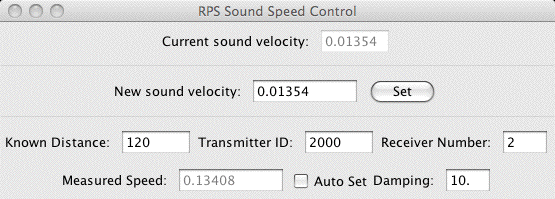JMRI: RPS Sound Speed Control

This window lets you monitor and control the speed of sound used by the RPS system.
RPS measures times, and uses a value for the speed of sound to calculate the corresponding distances that it uses to calculate positions. It's important that the speed of sound be very precise. If you want to measure an eight-foot distance to within 1/4 of an inch, you need to measure the speed of sound to about one part in a thousand, getting three significant digits right in the value. Since the speed of sound changes slightly with temperature, pressure and humidity, measuring it automatically is very useful.
This window displays the current speed value on the top line. Depending on how the system is operating, this might change occasionally.
Below that are two sections for controlling the speed.
In the middle section, you can directly enter a new value. Click "Set" to have it take effect immediately.
The RPS can also calculate the speed of sound from a measurement. To do this, you neeed to have a fixed RPS transmitter that's a known distance from a receiver. Enter the known distance, the ID number of the transmitter, and the number of the receiver to which you've measured the distance.
When the RPS system takes a reading from that transmitter, it will use the known distance and measured time to calculate a measured speed of sound. That value is displayed in the bottom line.
If you check the "Auto Set" box, RPS will slowly update the speed value it's using every time a reading is obtained. The "Damping" box determines how much averaging is being done: Larger values use a larger number of samples when averaging the update. The default value of 10 is a good compromise between keeping the value stable, and responding to changes.
Currently, the automatic update only works while this window is open. Once we have more experience with this tool, we'll probably make this feature operate automatically, without needing the window.
Thanks and congratulations to all who contributed! Contact us via the JMRI users Groups.io group.
Copyright © 1997 - 2024 JMRI Community. JMRI®, DecoderPro®, PanelPro™, DispatcherPro™, OperationsPro™, SignalPro™, SoundPro™, LccPro™, TrainPro™, Logix™, LogixNG™ and associated logos are our trademarks. Additional information on copyright, trademarks and licenses is linked here.
View the